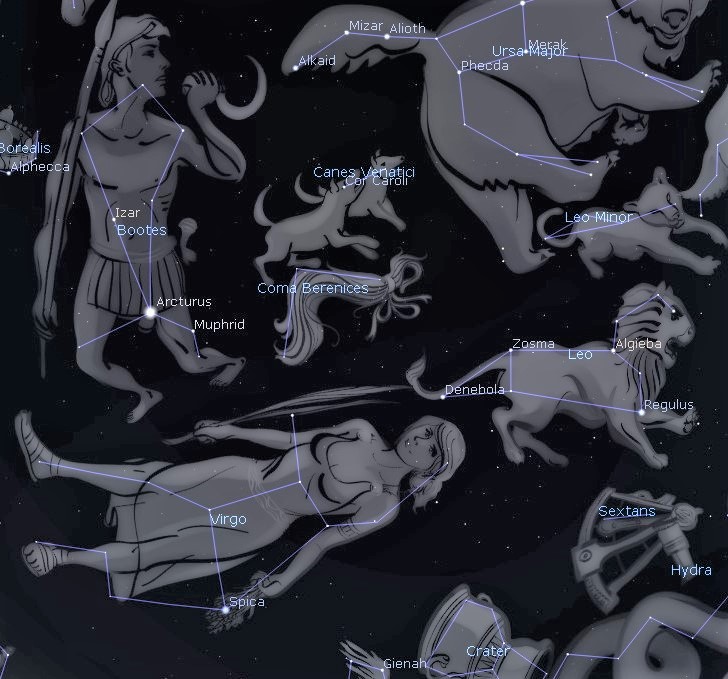This Week’s Sky at a Glance, 2023 April 8 – April 15

This Week’s Sky at a Glance, 2023 April 8 – April 15
As the Sun is setting this week, Spica is rising in the east. This blue giant star is the brightest in the constellation Virgo the Maiden, and the 14th brightest star of the night sky. It is usually located by following the arc of the Big Dipper’s handle to Arcturus and driving a spike to Spica. With Arcturus in Boötes, and Regulus (or dimmer Denebola) in Leo, it forms the Spring Triangle. If you toss in Cor Coroli in Canes Venatici, below the handle of the Big Dipper, you get the Spring Diamond.
Spica represents an ear of wheat in the hand of Virgo. In Greek mythology she was Demeter, the goddess of wheat or agriculture (Ceres to the Romans). The Sun passes through this constellation in harvest time, and it is in the head of Virgo at the autumnal equinox. Virgo is the second largest of the 88 constellations in terms of area of sky, trailing only Hydra the Water Snake. Coincidentally, it also trails Hydra in the sky, which can be seen stretching below Leo. The constellation is home to 11 Messier objects, second to Sagittarius in this distinction, and all of them are galaxies. Included in this group is M87, the huge galaxy that had the image of its central black hole shadow released four years ago.
This Week in the Solar System
Saturday’s sunrise in Moncton is at 6:46 am and sunset will occur at 7:56 pm, giving 13 hours, 10 minutes of daylight (6:52 am and 8:00 pm in Saint John). Next Saturday the Sun will rise at 6:33 am and set at 8:06 pm, giving 13 hours, 33 minutes of daylight (6:39 am and 8:09 pm in Saint John).
The Moon is near Antares in Scorpius on Monday and it reaches third quarter on Thursday. Venus makes a scenic pass of the Pleiades star cluster from Monday to Wednesday. Mercury is at its greatest elongation from the Sun on Tuesday, the same day that Jupiter is in solar conjunction. On Friday Mars is very near Mebsuta, a third magnitude double star in Gemini. Mars passed in front of this star in April 1976. Saturn is the lone naked-eye planet in the morning sky, awaiting the company of Jupiter next month.
On Sunday evening at 8 pm, tune in to the Sunday Night Astronomy Show via the Facebook page or YouTube channel of Astronomy by the Bay.
Questions? Contact Curt Nason
